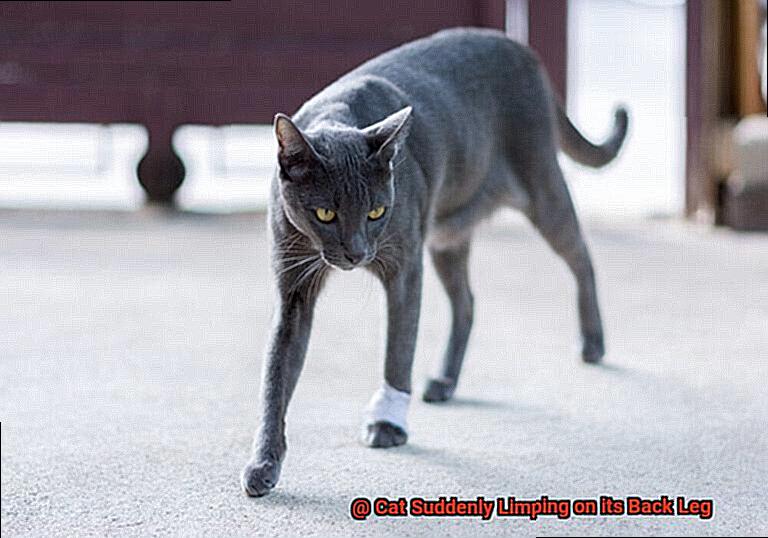Imagine this scenario: you walk through the door after a long day, and your beloved cat greets you with a limp in their back leg. Your heart races as you wonder what could have caused this sudden change.
As a devoted cat owner, it’s crucial to know that limping is not unusual in felines. Just like humans, cats can suffer from injuries that impact their mobility. Moreover, age-related problems such as arthritis can cause discomfort and stiffness in their joints.
Ignoring the limping and hoping for the best may be tempting, but it’s essential to take action immediately and address any underlying issues. Delaying treatment can lead to further complications and prolonged pain for your furry friend.
In this blog post, we’ll delve into the common reasons why cats suddenly start limping on their back legs and provide practical solutions to help them recover. Whether it’s a minor sprain or a more severe condition, we’ve got your back. So keep reading to become an expert cat owner and ensure your feline friend receives the care they deserve.

Causes of Sudden Limping in Cats

When you notice your furry friend suddenly limping, it’s natural to be concerned. While there are several reasons why cats start limping suddenly, it’s essential to understand the underlying causes so that you can take the necessary steps to help them heal.
One of the most common causes of sudden limping in cats is injury or trauma to their leg. Your kitty could have taken a tumble, gotten into a fight with a furry foe, or landed awkwardly after jumping from a high place. If your cat is limping on its back leg, it’s crucial to check for any signs of injury such as swelling or tenderness.
Another possible cause of sudden limping in cats is arthritis or joint pain. This degenerative joint disease can affect cats of all ages, but older cats are more susceptible. Arthritis causes stiffness and discomfort in the joints, making it difficult for your cat to move around normally. Your veterinarian may recommend joint supplements or medication to alleviate your cat’s symptoms if they are diagnosed with arthritis.

In some cases, limping may be a symptom of an underlying condition such as nerve damage or a tumor. While these conditions are less common, they should still be considered if the limping persists or worsens over time. Nerve damage can cause weakness or paralysis in the affected limb, leading to limping. On the other hand, bone cancer or tumors can cause pain and limping in affected limbs.
It’s important to note that cats are experts at hiding their pain and discomfort, so it may not always be apparent when they are limping or experiencing other symptoms. Therefore, it’s always a good idea to monitor your cat’s behavior closely and take them to a veterinarian if you notice any unusual changes in their movement or behavior.
Sudden limping in cats can be caused by various factors such as injury, arthritis, nerve damage, or cancer. As a responsible pet owner, it’s essential to stay vigilant and seek veterinary care if you notice any signs of discomfort or pain.
Injury as a Cause of Limping

One of the most common culprits is injury. Injuries can happen due to falls, fights, or even accidents around the house. We’ll dive into the different types of injuries that can cause sudden limping in cats.
One of the most frequent injuries that can cause sudden onset limping in cats is a sprain or strain. These occur when the ligaments or muscles in the leg are stretched or torn due to sudden movement or trauma. Your cat may experience pain and difficulty putting weight on the affected leg.
Fractures are another possible cause of sudden limping in cats. This occurs when one or more bones in the leg are broken due to trauma or excessive pressure. Fractures can be excruciatingly painful and often require immediate medical attention.
Dislocations are yet another possible cause of sudden limping in cats. This happens when the bones in the leg become separated from their normal position, causing pain and difficulty using the affected leg.
It’s crucial to remember that not all injuries that cause limping in cats are immediately apparent. In some cases, symptoms may take several days to appear.
If you suspect your cat has been injured, seek veterinary care as soon as possible to prevent further damage and help your feline friend recover as quickly as possible.
Arthritis as a Cause of Limping
While fractures and injuries are common causes of limping in cats, arthritis is also a leading culprit, especially in older cats. Arthritis is an inflammation of the joints that can lead to pain, stiffness, and difficulty in movement.
It can affect any joint in the body, including the hips, knees, and ankles. If your cat suffers from arthritis, it may limp on one or both back legs, and it may be hesitant to jump or climb stairs.
Unfortunately, the symptoms of arthritis can develop gradually over time, making it challenging for pet owners to notice them until they become severe. Cats may show signs of pain when touched or handled, and they may also have difficulty grooming themselves.
Over time, arthritis can lead to muscle wasting and weight loss. If left untreated, arthritis can severely impact a cat’s quality of life.
To diagnose arthritis in cats, a physical examination by a veterinarian is necessary. They may also need to take X-rays to assess the extent of joint damage. Treatment options for arthritis include medications to manage pain and inflammation, dietary changes to promote weight loss and reduce stress on joints, and physical therapy to improve mobility and strength.
Don’t forget that alternative therapies such as acupuncture, massage therapy, and herbal supplements can also help manage arthritis in cats. However, it is important to consult with a veterinarian before trying any alternative therapies to ensure they are safe and effective for your cat.
Arthritis can be a painful and debilitating condition for cats. But with proper treatment and management, cats with arthritis can continue to lead happy and active lives.
It is essential to keep an eye on your furry friend’s behavior and seek veterinary care if you suspect they may be suffering from arthritis.
Nerve Damage as a Cause of Limping
You know when something is off, like when they start limping. While arthritis is a common cause of limping, nerve damage is another possibility that you should be aware of. Nerves are the messengers between the brain and the rest of the body, including the legs. If there is damage to the nerves that supply the hind leg, it can lead to limping.

Nerve damage can be caused by various factors, such as trauma, infections, and certain medical conditions. For example, cats with diabetes are at risk of developing diabetic neuropathy which can cause hind leg weakness and limping. Other signs of nerve damage in cats may include muscle weakness or wasting, loss of coordination, and decreased reflexes.
If you notice any of these symptoms in your cat, don’t wait – seek veterinary care immediately. Treatment for nerve damage in cats may depend on the underlying cause. In some cases, surgery may be necessary to repair damaged nerves. Medications may also be prescribed to manage pain and inflammation. Physical therapy and rehabilitation exercises may also be recommended to improve muscle strength and mobility.
It’s critical to note that nerve damage can be a severe condition that requires prompt attention from a veterinarian. Delaying treatment can lead to further complications and potentially permanent damage. By seeking prompt veterinary care, you can help ensure the best possible outcome for your cat’s health and well-being.
It’s crucial to pay close attention to your feline friend’s behavior and symptoms. If you notice any signs of limping or nerve damage, seek veterinary care right away.
Cancer as a Cause of Limping
Cancer is one of the less common but potentially serious causes of limping in cats, especially in older cats. This devastating disease can affect their bones, joints, or soft tissues, causing pain and discomfort that may make them limp or avoid using their affected leg altogether. Osteosarcoma (bone cancer), chondrosarcoma (cartilage cancer), fibrosarcoma (connective tissue cancer), and lymphoma (cancer of the lymphatic system) are some types of cancer that may cause limping.
If you observe sudden limping in your feline companion and there is no apparent injury or trauma, it’s crucial to take them to the vet as soon as possible. The vet will conduct a comprehensive physical examination, take X-rays or other imaging tests, and possibly biopsy the affected area to determine if cancer is the underlying cause.
The treatment for cancer in cats varies depending on the type and location of the tumor, as well as its stage and spread. Surgery, chemotherapy, radiation therapy, or a combination of these may be recommended. Pain management and supportive care are also vital to keep the cat comfortable and improve their quality of life.
Prevention of cancer in cats involves minimizing their exposure to environmental toxins, providing a balanced and nutritious diet, and maintaining their overall health and wellness.
Regular check-ups with the vet can also help detect any signs of cancer early on when it’s more treatable.

Cancer is a severe cause of limping in cats that every pet owner should be aware of. If you notice any unusual behavior or symptoms in your cat, don’t hesitate to seek veterinary care.
How to Diagnose the Cause of Limping
Cats are known for their agility and curiosity, which can sometimes lead to injuries resulting in limping. As a responsible pet owner, it’s crucial to diagnose the cause of your cat’s limp to provide the necessary treatment and alleviate any discomfort. Here are five subtopics to help you diagnose the cause of your cat’s limp:
Observe visible injuries
The first step in diagnosing the cause of limping is to observe your cat’s behavior and look for any visible signs of injury or trauma such as cuts, swelling or bruises. If you notice any such injuries, it’s important to seek veterinary care immediately.
Conduct a physical exam
If there are no obvious causes of limping, it’s important to conduct a physical examination. This can be done by gently feeling around the affected area to detect any abnormalities, such as lumps or bumps, and noticing any reactions from the cat.

Diagnostic tests
In some cases, further diagnostic tests such as X-rays, ultrasounds or blood tests may be necessary to identify fractures or dislocations in bones, soft tissue damage like ligament or tendon tears, or underlying health conditions.
Monitor your cat’s condition
If the diagnosis is not apparent immediately, it may be necessary to monitor your cat’s condition for a few days to see if there are any changes or improvements. However, if the limp persists or worsens over time, seeking veterinary care is important.
Seek veterinary care
It’s always advisable to seek veterinary care if you notice any unusual behavior from your cat such as limping. A professional veterinarian can provide a thorough examination and identify underlying causes that might not be apparent.
Remember that early intervention is key when it comes to diagnosing and treating the cause of your cat’s limp. By following these steps and seeking veterinary care if necessary, you can help your feline friend recover quickly and return to their normal activities.
Limping is a common issue in cats that can be caused by various reasons such as injuries or underlying health conditions. By diagnosing the cause of your cat’s limp early on and seeking appropriate treatment, you can ensure their speedy recovery and get them back to their playful selves.
Treatment Options for Sudden Limping in Cats
The first step in treating sudden limping in cats is to determine the root cause. In some cases, rest and observation may be enough for your feline friend to heal on their own. However, if the limping persists or worsens, it’s crucial to seek veterinary attention immediately.
Medication is a common treatment option for sudden limping in cats. Pain relievers and anti-inflammatory drugs may be prescribed to alleviate discomfort and reduce inflammation in the affected leg. It’s essential to note that over-the-counter pain medications should never be given to cats without consulting a veterinarian first, as many of these medications can be toxic to felines.
If a fracture or dislocation is the cause of the limping, surgery may be necessary to realign the affected bone or joint. This procedure is typically done under general anesthesia and requires a period of recovery and rehabilitation afterwards.
Physical therapy is also an effective treatment option for cats with sudden limping. This can include exercises to improve strength and flexibility in the affected leg, as well as massage and other manual therapies to reduce pain and inflammation.
Alternative therapies such as acupuncture or chiropractic care may also be recommended by your veterinarian to help alleviate pain and promote healing in the affected leg.
It’s important to remember that the best course of treatment for sudden limping in cats depends on the underlying cause of the issue. Seeking prompt veterinary attention and following their recommended treatment plan is crucial for ensuring a full recovery for your feline friend.
Sudden limping in cats can be concerning, but there are various treatment options available. Resting and observing your cat’s condition may help, but seeking veterinary attention and following their recommended treatment plan is essential for a speedy recovery.
Prevention Strategies to Reduce Risk of Injury or Illness
One of the most important ways to do this is by implementing prevention strategies that reduce the risk of injury or illness. After all, nobody wants to see their beloved cat suddenly limping on its back leg or experiencing any other health issue.
To start, regular check-ups with a veterinarian are crucial for maintaining your cat’s overall health. This ensures that any potential issues can be detected and treated early on. It’s also important to keep your cat’s environment safe by removing any potential hazards, like sharp objects or choking hazards.
Keeping your cat indoors is another effective way to prevent accidents from outdoor hazards, such as cars or other animals. Additionally, providing regular exercise and playtime can help keep your cat strong and reduce the risk of injury. Activities like playing with toys or climbing structures, or even going for short walks on a leash can all contribute to strengthening your cat’s muscles.
Finally, maintaining a healthy diet and weight is essential for preventing injuries or illnesses in cats. Obesity can put extra strain on joints and lead to injuries or arthritis.
Feeding your cat a balanced diet and monitoring their weight can make all the difference in keeping them healthy and happy.
RP1Nsn_wWas” >
Conclusion
As a devoted cat parent, it’s crucial to understand that sudden limping in cats is not uncommon. There are several reasons why your furry friend may start limping on their back leg, such as injury, arthritis, nerve damage or cancer. Ignoring the limp and hoping for the best is not an option. Delaying treatment can lead to further complications and prolonged pain for your beloved pet.
To diagnose the cause of your cat’s limp, you can observe visible injuries, conduct a physical exam, perform diagnostic tests like X-rays or blood tests, monitor your cat’s condition and seek veterinary care if necessary. Early intervention is vital when it comes to identifying and treating the root cause of your cat’s limp.
Different treatment options are available depending on the underlying cause of the issue. Your veterinarian may recommend medication, surgery, physical therapy or alternative therapies such as acupuncture or chiropractic care to help alleviate pain and promote healing in the affected leg.
Prevention strategies like regular check-ups with a veterinarian, keeping your cat indoors, providing regular exercise and playtime while maintaining a healthy diet and weight can significantly reduce the risk of injury or illness in cats.

